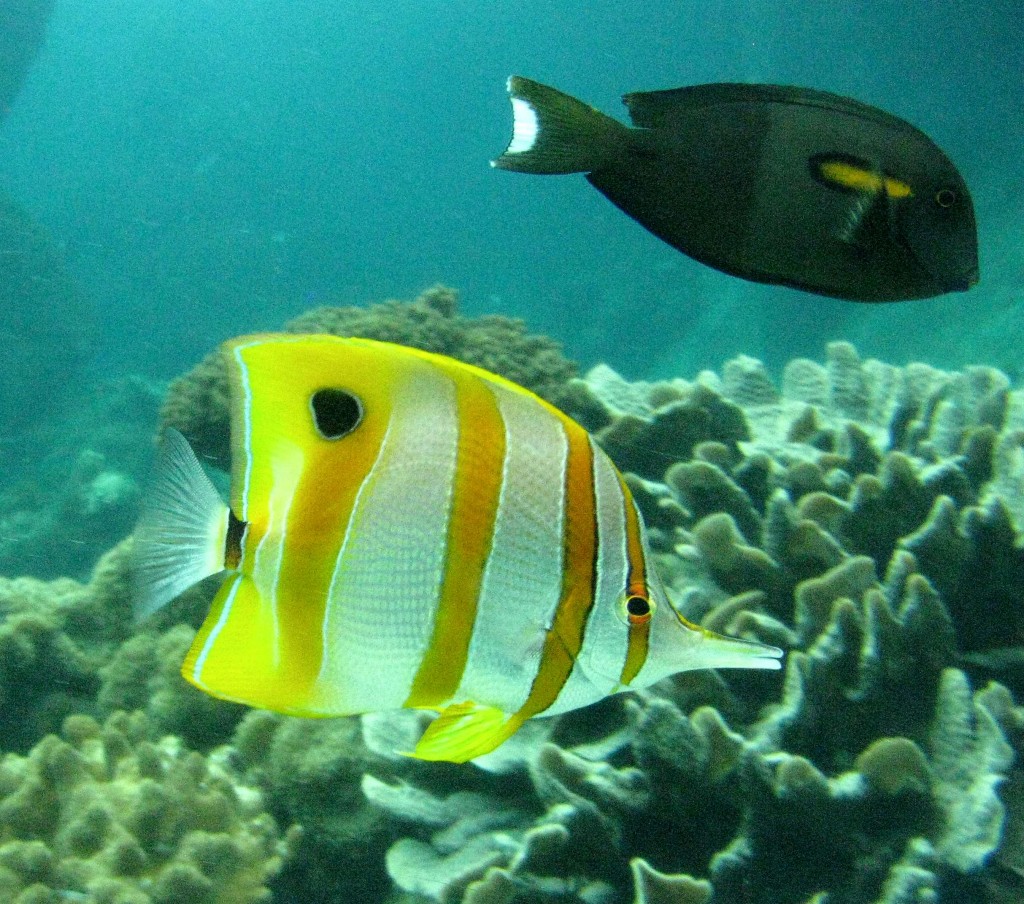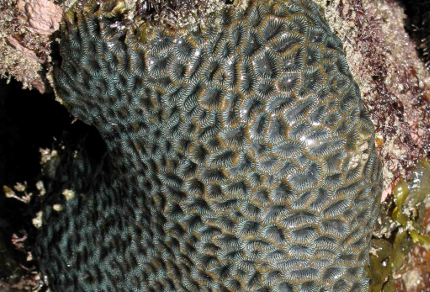
Great Barrier Reef Fishes at Reef HQ Aquarium, Townsville, Queensland (© Vilis Nams)
With Vilis’s and my tour to the outer Great Barrier Reef pending, I cycled to the library, signed out a couple of books on the Reef, and did some brushing up. Previously, I’d known that the GBR is the largest collection of coral reefs in the world, but Leslie Murdoch’s Discover the Great Barrier Reef Marine Park1 presented me with a delicious collection of statistics that helped me grasp the astonishing size of the Reef and its incredible diversity of marine life. I learned that the Reef is comprised of more than 2900 individual reefs plus about 900 islands.2 The reefs occur as three basic types – ribbon reefs, fringing reefs, and patch reefs.3 The islands exist as bare sand cays, permanent vegetated cays, or continental islands.2 Approximately 400 species of hard and soft corals can be found on the Reef, along with about 4000 kinds of molluscs (snails, clams, and relatives), 1500 species of fish, and thousands of other marine organisms, including colourful algae, eelgrasses, sponges, jellyfish, crustaceans (hermit crabs, barnacles, and relatives), echinoderms (sea cucumbers, sea stars, sea urchins, and so on), sea snakes and whales, birds, and endangered sea turtles and the dugong.2 The Great Barrier Reef extends from New Guinea in the north to south of Lady Elliott Island near Gladstone, Queensland4 and is the richest ecosystem on earth. Only tropical rainforests come close to it in terms of biodiversity.5

Coral at Low Tide, Alma Bay, Magnetic Island, Queensland (© Vilis Nams)
A coral reef forms when the rate of limestone accumulation from dead coral skeletons exceeds erosion caused by storms and coral-boring organisms.6 The basic building blocks of a reef are the corals, but the mortar cementing coral skeletons together is provided by species of encrusting coralline algae that grow over and among the coral skeletons and the remains of other reef animals.6 Even though corals exist in marine waters throughout the world – even Arctic and Antarctic waters – it’s only corals possessing symbiotic algae called zooxanthellae and which grow in warm climates and shallow waters that grow fast enough to form reefs.7 The Great Barrier Reef, although located in nutrient-poor water, is incredibly productive due to the presence of zooxanthellae in its corals (and in some other animals as well, notably large clams) and the warm, extremely clear water in which the reef is found, which facilitates photosynthesis by the zooxanthellae.8 Murdoch compares the daily productivity of the Reef to that of a lush, regularly fertilized sugarcane crop.8

Fringing Reef at Geoffrey Bay, Magnetic Island, Queensland (© Vilis Nams)
Ribbon reefs occur in northern Queensland and are wall-like reefs that grow along the edge of the continental shelf, forming barriers with passages occurring between ribbons.9 Patch reefs form circular or oval platforms growing on the continental shelf.9 Fringing reefs grow on the edges of the mainland or continental islands9 (having the same geology as the mainland), like Magnetic Island near Townsville. Vilis and I visited Magnetic Island in early August and caught our first glimpses of the Great Barrier Reef in the form of fringing reefs at Florence, Alma, and Geoffrey Bays. The only continental island within the GBR Marine Park that doesn’t have fringing coral reefs is brooding, mountain-clad Hinchinbrook Island,10 on which Vilis and I backpacked the Thorsborne Trail in September.
Coral cays are low islands formed from sand derived from coral debris; some are small and impermanent, shifting constantly with wave action, while others are larger, permanent and anchored by trees and other plants seeded by birds and waves.11
On our arrival in Australia, Vilis and I flew from Cairns south to Townsville, following the coastline. From the air above Cairns, our view was all green, cream, and blue, with a wide, olive-coloured river winding through emerald agricultural fields on a plain adjacent to a beach resembling pale lace edging a clear, turquoise ocean. Offshore islands rose from the Coral Sea, and the outer Great Barrier Reef was evidenced by vaguely circular and linear smears of palest aqua indicating shallow water over coral formations. That’s where we’re heading – to those outer Reef formations near Cairns – for a close encounter with the most diverse ecosystem on the planet.
Reference:
1. Lesley Murdoch, Great Barrier Reef Marine Park Authority. Discover the Great Barrier Reef Marine Park. 2003. Bay Books, Kensington, New South Wales, 96 p.
2. Ibid, p. 9; 3. Ibid, p. 18; 4. Ibid, p. 8; 5. Ibid, p.28; 6. Ibid, p. 30; 7. Ibid, p. 32; 8. Ibid, pp. 33, 40; 9. Ibid, p. 18; 10. Ibid, p. 23; 11. Ibid, p. 18-20.


